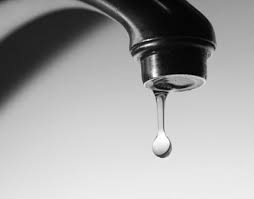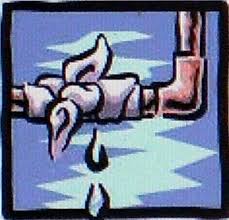
Plumbing includes all of the water supply and water waste lines. When the home's foundation is built, a plumber runs a supply line from the street through the foundation wall or the slab. From that point, they run the lines that supply water to the home to rooms where sinks, bathtubs, showers and other fixtures will be installed.
Copper piping is the traditional material most often used for water supply lines, although some plastic piping materials are gaining popularity and code approval. This diagram shows the path of the water to the fixtures, as well as the path for waste water from the fixtures through the drain waste vent pipes (DWV), and away from the home. The drain waste vent pipe is part of a home's plumbing system that is specifically used to carry waste water down and away from the home, and allows sewer gases to be pushed out through the roof. Drain waste vent pipes are typically plastic.
The plumbing system is required by code to keep the home's occupants safe, including:
- Automatic anti-scald feature at each shower fixture to keep water from getting too hot.
- Traps at each fixture to keep harmful sewer gases from leaking into the home. A trap is a curved section of plumbing pipe that seals the pipe to prevent sewer gas from getting into the home. It's also known as a p-trap. Traps also help prevent unwanted items, like hair or debris, or things that fall down the drain, like rings, from going down the drain and getting stuck in the waste system.
- Drain waste vent pipes to push out harmful sewer gases through the roof.
- As an additional health and safety measure, a specialized building code strictly regulates plumbing systems. A specialized plumbing inspector checks the installation when the pipes are being put in, and again when the home is finished -- right before closing -- to ensure all codes are followed and the plumbing is safe for the occupants.
The plumbing system also includes the water heater. The most common types of water heaters are gas, electric, oil or propane. If you have a gas water heater, direct vented is most desirable. If that's not an option, the second choice is power vented. Direct vented and power assisted are terms that describe how gases generated by the water heater are released from your home, which is critical for you and your family's health. Direct and power vented gas hot water heaters are less susceptible to combustion gases flowing back into the home because they force combustion gases out of the house.
The efficiency of a water heater is measured by its Energy Factor (EF). Hot water tanks with an EF greater than 0.56 for gas-fired units and 0.88 for electric units are recommended. For an upgraded price, you may be able to choose a heat pump water heater or instantaneous water heater. These are more efficient water heaters. You should discuss the features and benefits of both with your builder.
If your home is very large, there may be long pipe lengths between the water heater and one or more of the bathrooms, causing a delay in the hot water getting to that bathroom. Ask Franke Mechanical if this is the case in your home and what the delay might be. If it's more than you're willing to deal with, ask about installing a circulation system that can minimize the delay.
Remember, the choices you make regarding your plumbing system will help ensure your home performs the way you want it to, and that it's absolutely safe for you and your family. When your home is being designed, talk to Franke Mechanical about:
- The hot water tank's storage capacity -- is it enough for your family?
- Whether there's an expansion tank for the water heater, which is a safety measure to prevent pipes from rupturing.
- What type of water heater will be installed in your home and how combustion gases are expelled from the home (it should be either direct or power vented).
- How efficient your water heater is.
- Whether a more efficient system like a heat pump water heater or instantaneous water heater is appropriate and what the additional costs would be.
- What kind of delay you can expect in each of the bathrooms and whether the plumber can install a circulation system to minimize the delay.
- The locations of outdoor spigots, where you'll need to use a hose.




 #2 – Clogged drains. Many of these calls could be avoided by taking greater care in what you put down drains – especially the kitchen sink drain, the most used and most clogged drain in the house. I also recommend regular treatment with Bio-Clean or Super Citrus, biological drain cleaners sold only through plumbing contractors.
#2 – Clogged drains. Many of these calls could be avoided by taking greater care in what you put down drains – especially the kitchen sink drain, the most used and most clogged drain in the house. I also recommend regular treatment with Bio-Clean or Super Citrus, biological drain cleaners sold only through plumbing contractors.  #3 - Dripping faucets. This is an annoyance that most homeowners have to deal with from time to time as the washers in the faucets wear out with use. You can extend the life of your faucet washers by not turning them off with too much force.
#3 - Dripping faucets. This is an annoyance that most homeowners have to deal with from time to time as the washers in the faucets wear out with use. You can extend the life of your faucet washers by not turning them off with too much force. #4 - Leaking pipes. In extreme cases, these can cause expensive damage to floors and belongings. To stop a small leak from turning into a big one, take a look at your pipes periodically to check for rust or white lime deposits that may indicate a leak is starting.
#4 - Leaking pipes. In extreme cases, these can cause expensive damage to floors and belongings. To stop a small leak from turning into a big one, take a look at your pipes periodically to check for rust or white lime deposits that may indicate a leak is starting.  #7-8 – Running & leaking toilets. This is not only an annoyance, but a waste of water and money. Leaky toilets can cost you upwards of $100 a year on your water bills. If you hear a low humming noise, or if the toilet continues to run into the bowl after the toilet is flushed, it indicates that some part of the mechanism is out of order. Sometimes a minor juggling of the ball-cock or flush valve mechanism solves the problem without cost. Otherwise you may need to replace the entire mechanism.
#7-8 – Running & leaking toilets. This is not only an annoyance, but a waste of water and money. Leaky toilets can cost you upwards of $100 a year on your water bills. If you hear a low humming noise, or if the toilet continues to run into the bowl after the toilet is flushed, it indicates that some part of the mechanism is out of order. Sometimes a minor juggling of the ball-cock or flush valve mechanism solves the problem without cost. Otherwise you may need to replace the entire mechanism.  #9 - New faucet installation. Many homeowners replace faucets not only when they break down, but for decorative reasons as well. This is the ninth most common reason for a service call, according to the PHCIB. A few people buy a faucet from a home center and then call a plumbing firm to do the installation. This is okay, but be forewarned that in doing so, the plumbing firm will only
#9 - New faucet installation. Many homeowners replace faucets not only when they break down, but for decorative reasons as well. This is the ninth most common reason for a service call, according to the PHCIB. A few people buy a faucet from a home center and then call a plumbing firm to do the installation. This is okay, but be forewarned that in doing so, the plumbing firm will only #10 – Malfunctioning food waste disposer. This can be a messy headache for homeowners. Here are several tips to keep your unit in good working order. First, always run cold water when grinding to move the waste all the way down the drain lines. Fats and grease congeal and harden in cold water and can be flushed through the system. Hot water should not be used because it can dissolve fats and grease, which may then accumulate in the drain line. Almost all bio-degradable food waste can be fed into disposers. However, they should not be used to grind clam or oyster shells, corn husks or other material with high fiber content. Under no circumstances should you put glass, plastic or metal non-food materials through a disposer. This includes bottle caps, tin covers or aluminum foil, which are some of the items service technicians commonly find in clogged or broken disposers.
#10 – Malfunctioning food waste disposer. This can be a messy headache for homeowners. Here are several tips to keep your unit in good working order. First, always run cold water when grinding to move the waste all the way down the drain lines. Fats and grease congeal and harden in cold water and can be flushed through the system. Hot water should not be used because it can dissolve fats and grease, which may then accumulate in the drain line. Almost all bio-degradable food waste can be fed into disposers. However, they should not be used to grind clam or oyster shells, corn husks or other material with high fiber content. Under no circumstances should you put glass, plastic or metal non-food materials through a disposer. This includes bottle caps, tin covers or aluminum foil, which are some of the items service technicians commonly find in clogged or broken disposers.